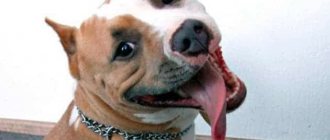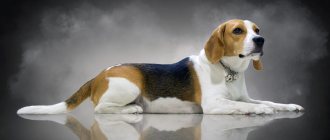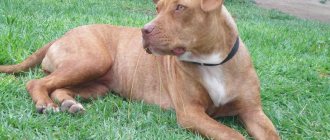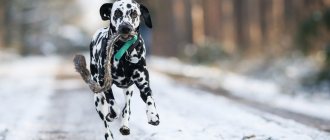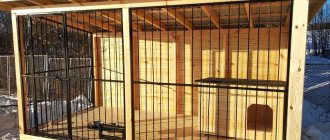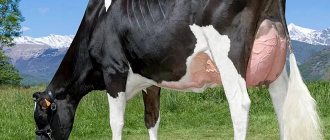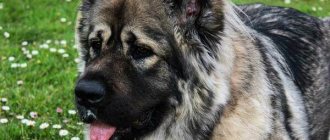This dog has the blood of the fighting dogs of Mesopotamia, the ancient dogs of Asia and the herding dogs of nomadic tribes, traces of which are forever lost in Time; it was well known in Persia by the legendary King Xerxes, and this Central Asian Shepherd is quite closely related to the famous Tibetan Mastiffs, Swiss St. Bernards and Great Danes.
Interesting fact: Alabais are among the top ten in the ranking of the largest dogs in the world, although they occupy only eighth place.
The official standard for this breed was established in 1989. According to the ICF classification, Alabai are quite rightly classified as molossians, that is, herding breeds, mastiffs and herds.
Alabai dog: characteristics of the breed
The large size, fairly high level of its intelligence and absolute self-confidence of this dog immediately attract attention and inspire great respect for it, and its famous protective qualities are beyond all praise.
general characteristics
A few words about the capabilities and some characteristics of the Central Asian Shepherd Dog, in very general terms.
- Aggression is above average, on a five-point scale – four out of five.
- Activity – four out of five.
- Trainability - three out of five.
- The need for special care is two out of five, obviously affecting the independence of this breed in earlier times.
- Friendliness - four out of five, and so on.
Height
In general, all canines, wild and domestic, large, medium and small breeds - no matter, Central Asian Shepherds are characterized by dimorphism, their males are larger than females, adult males reach a height of at least 70 cm at the withers, and females - at least 65 cm.
Weight
The same dimorphism is observed in the weight of these animals: a male Alabai weighs at least 50 kg, and a female weighs at least 40 kg.
Lifespan
With proper care and attitude, including activities and games - in general, any long-term physical activity, the Central Asian Shepherd Alabai lives on average 12 - 15 years.
Owners of Central Asian Shepherds should constantly remember that daily prolonged contact of any individual of this breed with the outside world, instead of constantly sitting at the booth on a chain or locked in an enclosure, is strictly obligatory and even vital for it.
History of the Alabai breed
Alabai is a product of “folk selection”: this herding breed was formed over thousands of years, “by itself”, under the most severe conditions of natural selection over a vast territory stretching from the southern foothills of the Urals to modern China, the Caspian Sea and Afghanistan and has reached us almost unchanged, in its original form .
Terracotta figurines of dogs, very similar in appearance to modern Alabais, are found in cultural layers of the Bronze Age, which allows us to estimate the average age of this ancient dog breed at 3000 - 4000 years. It is curious that even then these dogs had their ears and tails docked.
In modern Turkmenistan, the Central Asian Shepherd Dog, known there as a wolfhound, is considered a national treasure and therefore is prohibited from being exported outside the republic.
Feeding
The Central Asian Shepherd is not whimsical; home-cooked food suits it. The basis of the diet is cereals, vegetables, lean meat and offal; You can add fermented milk products and eggs.
You can use industrial, preferably high-quality feed.
Do not feed sweet, salty or flour foods. The dog should have constant access to clean water.
What does the Alabai breed look like?
Without a doubt, the phenotype of modern Alabais reflects the features of their distant ancestors: they have “impressive” dimensions, their strength is so obvious and, finally, they have thick hair.
And Alabai also have a heightened sense of self-esteem, they are certainly smart and quick-witted, and each of them knows his own worth well, and therefore from the owner and his immediate circle they demand basic respect for themselves and their rights - which, as it seems to us now, quite reasonable and even more than fair.
Head
Massive, proportional to the body - a shape more reminiscent of a rectangle with smoothed corners. The skull is flattened, the occipital part is prominent.
Muzzle
Medium length, with a visually well-defined, clearly defined chin. The nose is fleshy, large, black, although in Alabais of white and fawn colors it can be light.
The jaws are massive, wide, and have a standard scissor bite; the lips have black pigmentation, the upper lip in a calm state of the dog completely hides its lower jaw. It is this characteristic feature, or more precisely, one of these appearance features that allows us to classify Alabais as mastiffs.
Eyes
Oval in shape, rather medium in size, set wide apart. The color of the iris is light and dark brown, the eyelids are black.
Ears
Alabai fold-ears, their small ears are triangular in shape. By the way, in some countries the ears of Alabais are cropped.
Neck
Muscular, medium length. The characteristic dewlap is a special distinguishing feature of this breed.
Back
Straight, muscular, prominent loin, short but powerful.
Breast
Wide, with a wedge that widens towards the shoulder blades, and its bottom reaches the level of the front joints, sometimes even lower.
Tail
High-set, powerful, often crescent-shaped until docked, sometimes curled into a ring in the last third. Official breed standards allow these two options.
Forelegs
Strong, wide bones, straight.
Hind limbs
They are as strong as the front ones, set slightly to the side.
Paws
Rounded, any color of claws is allowed.
Wool
Straight, thick, rough - in a word, luxurious, with a developed undercoat. It can be short or long – in the second case there is also a small mane.
Color
Almost any, with the exception of black, brown, blue.
Shades of colors
- White . The white color of the Alabai is not always snow-white. There are a lot of white dogs, whose coat color has a pale cream or barely noticeable grayish tint. With this color, dogs, as a rule, have a black or dark brown pigmentation on the nose, rims of the eyelids and lips.
- Black and white . On the main black background there are quite large white markings, which, as a rule, are located on the head, muzzle, neck, chest, paws and tip of the tail. The belly and the inside of the hind legs may also be white.
- Red and white . The main background is reddish or fawn, on which the white markings are located.
- Gray-white . With this color, on a zone-gray background there are white markings, which, depending on the main shade of the coat, can either contrast or almost merge with it.
- Tiger white . On a dark or light brindle background there are white spots of a fairly large size.
- Tricolor . The main black color is complemented by reddish or fawn markings, as well as white markings.
- Motley . The main background is white, with small spots of black, brindle or reddish color scattered across it.
- Speckled . With this color, small colored markings in the form of specks are scattered on a white background.
With black, red, gray or brindle-white color, white markings should cover no more than 50% of the animal’s body.
Photos of Alabai
Photos of adult Alabai dogs
Photos of puppies
Photos
Next Previous
Charming hostess of Alabai
A happy family!
Nice smile!
Trusted friend
Next Previous
Education and training
These two points are simply strictly necessary in the life of not only the animal itself, with its pronounced protective, genetically determined instincts, but also its owner himself. This applies to the latter even more so.
Classes with alabai should be daily, systematic, lasting at least half an hour each. Ideally, all family members will also be involved in the process of education and training, each of whom will take the most direct and active part in all this.
Let us note, by the way, that by the age of seven months the puppy should already be socialized and have a correct understanding of the surrounding reality and elementary commands like “Come to me!”, “Sit!”, “Place!” and all the others, not too complex, understand and carry them out without hesitation. Although the latter is more likely from the realm of fantasy - Alabai dogs are smart, thoughtful and in vain, out of nowhere, they will not throw out some tricks “for nothing”.
Character
Alabais are fearless, proud dogs that do not tolerate rough treatment. They have high intelligence and are easy to train, as the pack instinct has been ingrained in them for centuries. They calmly obey a person who is recognized as a leader, but at the same time they are freedom-loving and independent. It is wise to seek the services of a professional dog handler, who will make the dog not only a reliable guard and watchman, but also a companion capable of getting along with all family members, including small children.
The Alabai have a complex character that requires a special approach. Bitches are cautious and suspicious, they sense the object of a threat, even if it is at a distance. They are more obedient and understand commands well, but at the same time they are cunning and try to get their way. That is why you should not overly pamper a shepherd dog, but talking as with an equal, stroking and other ways of showing care are welcome.
Males are courageous and reckless; in case of danger they become unusually aggressive and can act without warning. They are undoubted “territorialists”, and consider their territory, the yard and the area adjacent to it, inviolable. There are known cases when Alabai, without warning, attacked passers-by who happened to be on the street. But outside their territory, shepherd dogs do not show aggression and are quite good-natured. But if the animal feels a threat to its owner, it will inevitably rush at the offender.
The best living conditions for Alabai are a private house, a spacious enclosure. It is not recommended to put him on a chain, since shepherd dogs do not tolerate captivity and, not being able to move freely, can become aggressive.
You cannot punish and scold an Alabai for no reason! Representatives of this breed are vindictive and touchy.
Care and maintenance
According to the same Hamburg account, the alabai is unpretentious and does not need special care - and here, for sure, the difficult past of its ancient ancestors again affects. However, the owner will still have to follow the basic rules of dog hygiene.
Yes, there is one very significant addition - such a large dog is poorly adapted to life in a city apartment, it requires and even vitally needs the space of a country estate - a house with a garden plot and its own enclosure with an insulated kennel of a suitable size, in which the dog could rest peacefully , stretching out to its full truly gigantic height.
As for the actual care of the Alabai, the concept of “care” in this particular case includes the following mandatory “options”:
- Bathing - at least once a month, followed by thorough drying with a towel.
- Preventive examination of the mouth, ears and eyes - the more often the better.
- Hair care - periodic combing to avoid tangles; the luxurious wool of the Alabai also serves purely utilitarian purposes: if a person has hands “where it is needed” and a head not made from compressed sawdust, it, the wool of the Central Asian Shepherd, produces good woolen products; and lastly, combing is carried out more often during the molting period.
Who is the Central Asian Shepherd Dog suitable for?
Alabai is not a breed for everyone. It requires a steady hand and a special approach to training. A dog will not respect an owner who lets its upbringing take its course. It should be remembered that many of its qualities are innate, so it is extremely difficult to influence them. However, with a competent approach, internal energy and aggression towards others can be successfully managed. Then the alabai will become the most reliable defender of the house and all its inhabitants.
A firm but fair owner will raise the alabai to be a protector and a loyal friend
The ideal owner for a Central Asian Shepherd is a man who leads an active lifestyle, perhaps playing sports. It is much more difficult for women to cope with such a large and wayward dog. Those who have no experience in dog breeding should not own an Alabai.
Even with all the positive qualities, the young Alabai is not suitable for a beginner
Health and diseases of Alabai
From the same ancient ancestors, the Alabai inherited excellent health, which, however, does not mean that a person should not monitor their health at all. Periodic examination of the pet in the hospital by veterinarians and consultations with canine specialists are welcome; they will undoubtedly do honor to the pet’s owner, as well as timely antiparasitic treatment or wearing a special anti-flea collar by the pet, as well as periodic, if necessary, vaccination of the dog. For the same “every fireman.”
The real Achilles heel of these dogs is their musculoskeletal system.
Vaccinations
The dog is given its first vaccination at the age of 2 months. After 3 weeks, the vaccine is given again. The next vaccination is given after 6 months. Further, vaccinations are given once a year. All medical procedures must be performed by qualified professionals.
Injections can only be given to a healthy dog. After vaccination, you must comply with the quarantine regime (water procedures and heavy physical activity are contraindicated). For injections, it is better to use high-quality polyvalent vaccines that meet international quality standards.
Pros and cons of the breed
It is clear, as in everything and everywhere, this breed has its pros and cons, and it is still unknown what is more here.
The advantages of Alabaev are usually called:
- devotion,
- goodwill,
- outstanding security abilities,
- physical endurance,
- minimal time and financial costs for care, and so on.
And of the minuses -
- the need for a large area for comfortable living,
- regular increased physical activity, which means daily exercise with your pet, including in special areas, long walks, etc.
- incompatibility with four-legged fellows,
- heavy shedding,
- unpredictability in an emergency.
How to choose a puppy
"Elementary Watson!" – the key to choosing the right purebred and healthy puppy will be the choice of the future pet and, at the same time, another family member in a specialized nursery or from a trusted breeder. In the meantime, here are some simple tips.
- The puppy must be at least two months old.
- The puppy's mother must be between two and a maximum of eight years old - this is the only way to guarantee normal, physically and mentally healthy offspring from her.
- The maximum permissible number of puppies in one litter, at which this number also guarantees the health of newborns, is six. This is the opinion of experts.
- The same experts advise choosing females if there are small children in the house - the whole point is that Alabai girls are more curious and active and, thus, they can become indispensable play partners for children, their reliable companions.
- The most important thing is the appearance of the puppy - he should be hyper-active, eat with the appetite of a wolf, and his hair, short and plush, should not have any visible defects, just as there should be no foreign discharge from the ears and eyes of the future pet.
How much does alabai cost?
Prices for Alabai puppies depend on a number of factors - not least the color of the coat, and white Central Asian Shepherds are much more valuable, they are significantly more expensive. The location of the nursery also affects the price; a puppy from a metropolitan establishment will be more expensive than from a nursery in the periphery.
In short, prices for Alabai puppies start at 15,000 rubles, this is the average price for a pet-class puppy, while show-class puppies with a “future” cost two or even three times as much, since they immediately the question arises about the whole package of official papers; tribal marriage will be cheaper.
Owner reviews
Frankly speaking, not everyone is able to have such a breed in a city, and here, if the owner copes with all his responsibilities properly, a monument should be erected to him; such a person himself must be provided for and stand firmly on his feet financially, first of all, in terms of. Not to mention personal responsibility.
Those who have endured and are still bearing on their shoulders all the hardships associated with close friendship with the Alabai (read, living together with him and properly caring for him), first of all note that these dogs are certainly smart, and if they bark, then only for the sake of business, to “further ostracize” the stranger, and that with proper upbringing, such a dog can rightfully be called golden.
They also say that in the city such dogs do not live to their middle years and die at the age of nine and ten.
Interesting facts about Alabai
Some people don't know that:
- Alabais are among the ten largest breeds.
- The dog Bulldozer has the heaviest weight. The dog lives in Russia and weighs 125 kg.
- The word "alabai" is translated as "pockmarked" or "motley".
- As a form of protest, the dog may relieve itself in inappropriate places.
- The breed is prohibited in some countries because it is considered a fighting breed.
- Alabais are present in the films “Okhlamon”, “Makar the Pathfinder”.
- In Uzbekistan, dogs are called Buribasars, which translates as “wolfhound”.
- Small puppies love to bite, which is due to the presence of an innate hunting instinct. During training, you need to eradicate this habit.
- The dog is capable of severely injuring unfamiliar animals or people entering its territory.
Despite the fact that the Alabai is considered a good companion and assistant, it should be owned by a person who has the patience and time to train.
